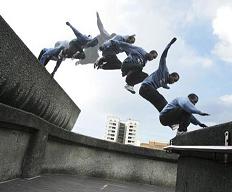|
Parkour is most often
practiced outdoors, usually without spectators, and is not considered to be
performance.According to REFO, "the physical aspect of parkour is getting
over all the obstacles in your path as you would in an emergency. You want
to move in such a way, with any movement, as to help you gain the most
ground on someone or something, whether escaping from it or chasing toward
it."Thus, when faced with a hostile confrontation with a person, one will be
able to speak, fight, or flee. As martial arts are a form of training for
the fight, parkour is a form of training for the flight.
A characteristic of parkour is efficiency. Practitioners move not only as
rapidly as they can, but also in the most direct and efficient way possible.
This characteristic distinguishes it from the similar practice of free
running, which places more emphasis on freedom of movement and creativity.
However, it is not certain whether freerunning was initially intended to be
similar to parkour.Efficiency also involves avoiding injuries, both short
and long term. This idea embodying parkour's unofficial motto is être et
durer (to be and to last). Those who are skilled at this activity normally
have an extremely keen spatial awareness.
To understand the philosophy of parkour takes quite a while, because you
have to get used to it first. While you still have to try to actually do the
movements, you will not feel much about the philosophy. But when you're able
to move in your own way, then you start to see how parkour changes other
things in your life; and you approach problems — for example in your job —
differently, because you have been trained to overcome obstacles. This
sudden realization comes at a different time to different people: some get
it very early, some get it very late. You can't really say 'it takes two
months to realize what parkour is'. So, now, I don't say 'I do parkour', but
'I live parkour', because its philosophy has become my life, my way to do
everything.
—Andreas Kalteis,
Movements
There are fewer predefined movements in parkour than gymnastics,
as it does not have a list of appropriate "moves". Each obstacle a traceur
faces presents a unique challenge on how they can overcome it effectively,
which depends on their body type, speed and angle of approach, the physical
make-up of the obstacle, etc. Parkour is about training the "bodymind" to
react to those obstacles appropriately with a technique that works. Often
that technique cannot and need not be classified and given a name. In many
cases effective parkour techniques depend on fast redistribution of body
weight and the use of momentum to perform seemingly impossible or difficult
body manoeuvres at speed. Absorption and redistribution of energy is also an
important factor, such as body rolls when landing which reduce impact forces
on the legs and spine, allowing a traceur to jump from greater heights than
those often considered sensible in other forms of acrobatics and gymnastics.
According to David Belle, you want to move in such a way that will help you
gain the most ground as if escaping or chasing something. Also, wherever you
go, you must be able to get back, if you go from A to B, you need to be able
to get back from B to A,but not necessarily with the same movements or
passements.
Training places
Unlike many other activities, parkour is not currently practiced in
dedicated public facilities (e.g., skateparks), although efforts are being
made to create places for it.raceurs practice parkour in urban areas like
gyms, parks, playgrounds and abandoned structures. Concerns have been raised
regarding trespassing, damage of property,and the practice in inappropriate
places.However, most traceurs will take care of their training spots and
will remove themselves quickly and quietly from a public place if asked.
There is also the concern that practitioners are needlessly risking damage
to both themselves and rooftops by practicing at height, with police forces
calling for practitioners to stay off the rooftops.Figures within the
parkour community, including parkour instructors and David Belle, agree that
this sort of behaviour is not to be encouraged.These issues, however, do not
appear to apply to the majority of practitioners whose relationship with
authorities is generally a positive one.
Accessories
There is no equipment required, although practitioners normally train
wearing light casual clothing:
* Light upper body garment — such as T-shirt, sleeveless shirt or crop top.
* Light lower body garment — such as light trousers or light shorts.
The only gear really required is comfortable athletic shoes that are
generally light, with good grip. British based company Inov-8 offers a
parkour specific line. Some traceurs use sweat-bands for forearm protection,
or even thin athletic gloves to protect the hands, but most traceurs advise
against this as it reduces grip and feel.
Filmography of Parkour
* Yamakasi (2001)
* District B13 (2004)
* The Great Challenge (2004)
* Casino Royale (2006), and its sequel Quantum of Solace (2008)
* Breaking and Entering (2006)
* Live Free or Die Hard (2007)
* The Bourne Ultimatum (2007)
* American Pie Presents: Beta House (2007)
* Punisher: War Zone (2008)
* Ayan (film) (2009)
* Paul Blart: Mall Cop (2009)
* District B13 Ultimatum (2009)
Notable parkour documentaries include:
* Jump London (2003)
* Jump Britain (2005)
* Génération Yamakasi — Vol au dessus des cités (2006)
* Jump Westminster (2007)
* Parkour Journeys (2007)
* Pilgrimage (2008)
* Point B (2009) (Requires Flash to view Documentary)
* The life and times of two traceurs: Luke and Miles Deverson. (2009)
* Parkour - The Nature Of Challenge (2009)
* 3RUN Video Clips of Parkour.
Television series:
* Heroes, Season 2 (2007)
* Top Gear, Series 8, Episode 7 (2006) - Traceurs race a Peugeot 207 across
Liverpool
* Can we help?, Episode 3, Friday 27 February , 2009 - Pete Investigates.
* MTV’s Ultimate Parkour Challenge, Thursday, October 22nd, 2009. MTV and
The World Free Running and Parkour Federationannounced they will air the one
hour special that stars 8 Wfpf athletes: Daniel Ilabaca, Ryan Doyle, Tim
“Livewire” Shieff, Pip Anderson, Daniel Arroyo, King David, Brian Orosco,
and Michael Turner.
Parkour has also been featured in video games:
* inFamous (2009)
* [PROTOTYPE] (2009)
* Mirror's Edge (2008)
* Tomb Raider: Underworld (2008)
* Assassin's Creed (2007) and its sequel Assassin's Creed II (2009)
* Uncharted: Drake's Fortune (2007) and its sequel Uncharted 2: Among
Thieves (2009)
* Prince of Persia (1989–2008)
* Splinter Cell and its various sequels (2002–present)
* Tony Hawk's American Wasteland
Music Videos:
* Three Doors Down - It's Not My Time (2008)
* Madonna - Hung Up (2005)
* Madonna - Jump (2006)
* In Flames - Touch of Red
* MURS - Can It Be
* Guano Apes - Big in Japan |














